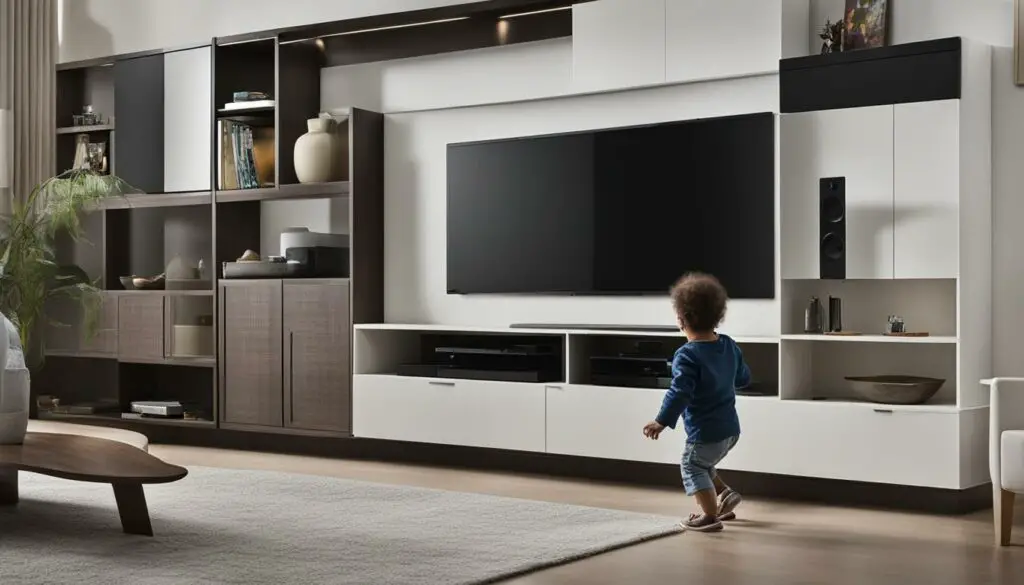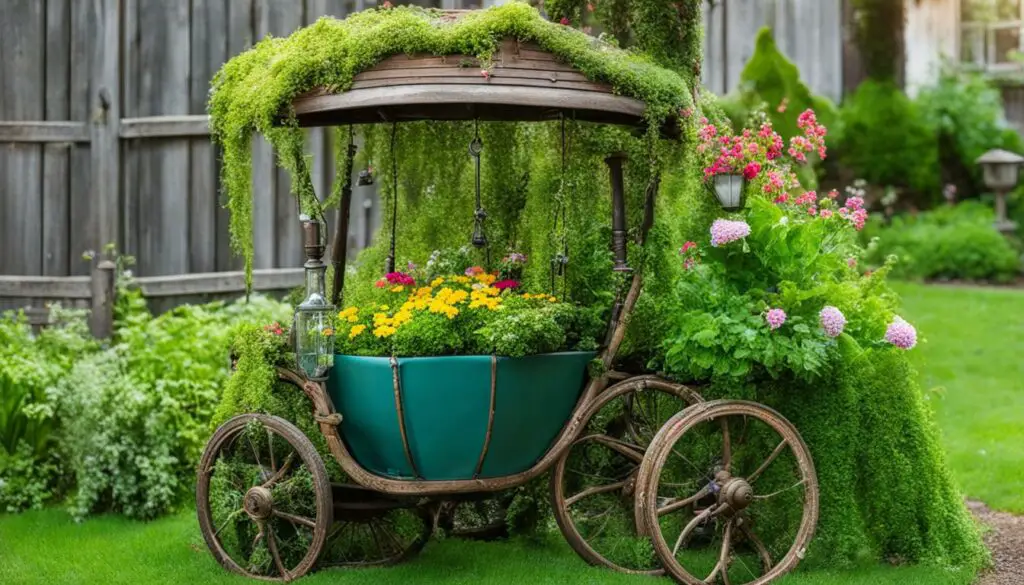When it comes to your child’s safety, baby proofing your home is essential. One area that often gets overlooked is the fireplace. However, the dangers of a fireplace for babies and toddlers cannot be ignored. From burns to other injuries, the risks are high, but fortunately, there are many ways to baby proof your fireplace.
So, how can you baby proof your fireplace and keep your child safe? In this article, we’ll explore the different types of baby proofing products available for fireplaces, provide step-by-step instructions on how to install them, and offer safety tips for using a fireplace with babies.

Key Takeaways:
- A fireplace can be dangerous for babies and toddlers.
- There are various baby proofing products available for fireplaces.
- Installing these products correctly is essential for maximum safety.
- Following safety tips when using a fireplace with babies is crucial.
Understanding the Risks
Fireplaces can pose a significant danger to babies and toddlers, and it’s essential to understand the risks they present. The most common danger is burn injuries, which can lead to severe consequences, including hospitalization or even death. Burns can occur from direct contact with the fire, hot ashes, or embers. Children may also trip and fall onto the fireplace, resulting in additional injuries.
It’s crucial to take preventive measures to ensure your child’s safety. The American Academy of Pediatrics recommends installing barriers to prevent access to fireplaces, wood stoves, and other sources of heat.
Aside from burns, there are other risks associated with fireplaces, such as carbon monoxide poisoning and inhaling toxins from the burning materials. Be sure to keep your fireplace well-maintained and have it inspected regularly to avoid these kinds of dangers.
Preventing Burn Injuries
The first step in preventing burn injuries is to keep children away from the fireplace. Installing a barrier or gate around the fireplace is the most effective way to keep your child from getting too close to the fire. However, it’s vital to ensure that any barrier you choose is secure and cannot be easily moved or toppled over. The barrier should also be tall enough to prevent the child from climbing over it or reaching through it.
Another important step in preventing burn injuries is to keep the fireplace clean. Remove ashes and debris regularly and ensure that the fireplace grate is stable and in good condition. Never leave a fire unattended, and never leave your child alone in a room with a lit fireplace. Keep flammable materials such as curtains, furniture, and newspapers away from the fireplace to avoid accidents.
Finally, invest in fireplace tools to control the fire safely. Keep a screen in front of the fireplace to prevent sparks and embers from flying out and burning your child. Use fireplace gloves when handling hot materials, and keep a fire extinguisher nearby in case of an emergency.
Child Safety First
When it comes to child safety, it’s always better to err on the side of caution. Never assume that your child is safe around a fireplace. Install baby proofing products to create a barrier between your child and the fire. Teach your child about the dangers of fireplaces and how to avoid them.
In summary, fireplaces pose a significant danger to young children. Prevent burn injuries by keeping your child away from the fireplace and investing in safety barriers and tools. Always keep an eye on your child when near a fireplace and ensure that you maintain the fireplace properly to prevent accidents. By taking these steps, you can ensure your child’s safety and enjoy the warmth and ambiance of a fireplace without worrying about the risks.
Baby Proofing Products for Fireplaces
Baby proofing your fireplace is a critical step towards ensuring your child’s safety. There are several types of baby proofing products available that can help protect your little ones from the potential dangers of a fireplace. Here are some of the most popular options:
| Product | Description |
|---|---|
| Fireplace gates | These are metal or wooden barriers that can be attached to the walls on either side of the fireplace. They create a physical barrier between your child and the fireplace, preventing them from getting too close. |
| Fireplace screens | These are decorative screens that can be placed in front of the fireplace to prevent your child from getting too close. They can be made from a variety of materials, including metal and glass. |
| Fireplace covers | These are heavy-duty covers that can be placed over the opening of the fireplace. They prevent your child from accessing the fireplace and can be removed when you want to use it. |
| Fireplace guards | These are transparent barriers that can be attached to the front of the fireplace. They allow you to enjoy the warmth and beauty of the fireplace while keeping your child safe. |
| Fireplace barriers | These are flexible barriers that can be attached to the walls around the fireplace to prevent your child from getting too close. They are made from materials like foam and can be easily removed when the fireplace is in use. |
When choosing a baby proofing product for your fireplace, consider the size and layout of the room, your child’s age and mobility, and your personal preferences.
Installing Baby Proofing Products
Installing baby proofing products for your fireplace is a simple process that can be done in just a few steps:
- Measure the area around your fireplace to determine the size and type of baby proofing product you need.
- Choose a product that fits your needs and preferences.
- Follow the manufacturer’s instructions for installation. This may involve drilling into the walls or using mounting hardware.
- Test the product to make sure it is secure and cannot be easily removed by your child.
Make sure to check the product regularly to ensure it is still in good condition and functioning properly.
Safety Tips for Using a Fireplace with Babies
Even with baby proofing products in place, it’s important to take additional safety measures when using a fireplace with babies or toddlers. Here are some tips:
- Always supervise your child when the fireplace is in use.
- Use a fireplace thermometer to monitor the temperature of the room.
- Keep flammable materials like curtains and furniture away from the fireplace.
- Teach your child about the dangers of the fireplace so they understand why it’s important to stay away from it.
By taking these precautions, you can ensure that your child stays safe and sound around your fireplace.
Installing Baby Proofing Products
Now that you have decided to baby proof your fireplace, let’s explore how to install different types of baby proofing products.
Installing Fireplace Gates
The first step is to measure the dimensions of your fireplace to ensure that the gate fits perfectly. Then, attach the mounting brackets to the wall on both sides of the fireplace, making sure they are level. Once the brackets are securely attached, you can snap the gate into place.
Installing Fireplace Covers
Measure the width and height of your fireplace to determine which size cover you need. If the cover requires adhesive strips, attach them to the edges of the cover. Next, align the cover with the fireplace opening and press down firmly to secure it in place. If the cover is a freestanding model, simply place it in front of the fireplace.
Fireplace Safety Installation
It is essential to follow the manufacturer’s instructions for each safety product and ensure it is installed correctly. A poorly installed gate or cover can be dangerous for your child. Make sure that the products are securely attached and the edges are not loose. Keep an eye out for any gaps or openings that your child could potentially slip through.
Remember to test the installation by giving it a good shake or push. If it moves or wiggles, adjust the installation until it is stable and secure.
Installing baby proofing products for your fireplace can be an easy and quick process. With these tips, you can keep your child safe while enjoying the warmth of your fireplace.
Safety Tips for Using a Fireplace with Babies
Fireplaces can be dangerous for babies and toddlers, but with the right precautions, you can use your fireplace safely. Here are some safety tips:
- Always supervise your child when the fireplace is in use.
- Keep a safe distance between your child and the fireplace. Consider using a safety gate to create a physical barrier.
- Teach your child about the dangers of fire and how to stay safe.
- Ensure smoke detectors and carbon monoxide detectors are installed and functioning properly.
- Clean your fireplace regularly to prevent the buildup of creosote, which can cause chimney fires.
- Use only dry wood or manufactured logs in your fireplace. Avoid burning paper, cardboard, or other materials.
- Keep flammable materials, such as curtains or furniture, away from the fireplace.
- Do not leave the fireplace unattended while it is burning.
- Use fireplace tools, such as tongs and pokers, to handle burning logs and embers.
By following these safety tips, you can use your fireplace without worrying about the safety of your child.
Insulating Your Fireplace
Insulating your fireplace is an essential step in childproofing your home. Without proper insulation, the fireplace can pose a significant danger to your child. Insulating your fireplace can help prevent accidents and injuries by reducing the risk of burns and heat exposure.
There are several different options for insulating your fireplace, including fireplace padding, heat-resistant materials, and other childproofing products. A fireplace pad can be placed in front of the fireplace to provide a cushioned barrier, while heat-resistant materials can be used to protect the area surrounding the fireplace from excessive heat.
When insulating your fireplace, it’s important to consider the type of insulation you need. Some insulation options may be more suitable for gas fireplaces, while others may be more suitable for wood-burning fireplaces. Additionally, you may need to install insulation both inside and outside of your fireplace to ensure maximum safety.
If you’re not sure how to properly insulate your fireplace, it’s best to consult a professional. They can provide you with advice on the best insulation options for your specific fireplace and ensure that everything is installed correctly. By properly insulating your fireplace, you can enjoy the warmth and comfort it provides while keeping your child safe from harm.
Monitoring Fireplace Temperature
When it comes to using a fireplace with babies or toddlers in the house, monitoring the temperature is crucial for preventing burns and ensuring maximal safety. The temperature inside a fireplace can reach extremely high levels, posing a serious risk to your child’s safety.
Therefore, investing in a fireplace thermometer is one of the most efficient ways to monitor the temperature of your fireplace. A thermometer allows you to keep track of the temperature and make sure that it remains below a safe level. You can find several models of fireplace thermometers on the market.
In addition to using a thermometer, you can also employ other devices to help monitor the temperature of your fireplace. For example, heat sensors can alert you if the temperature in the room rises above a certain point. There are also smart thermostats that allow you to regulate the temperature and monitor the fireplace from your smartphone.
Always keep in mind that monitoring the temperature is only one aspect of using a fireplace safely. Make sure to follow the other safety tips discussed in this article to create a secure environment for your child.
Enclosing the Hearth
If you have a hearth in front of your fireplace, it’s important to create a physical barrier between your child and the fireplace. This will prevent your child from accidentally crawling or walking into the fireplace and suffering burns or other injuries. Enclosing the hearth area is an effective way to achieve this.
There are several types of hearth enclosures on the market, including gates, screens, and barriers. Whether you choose a permanent or temporary enclosure will depend on your specific needs and preferences. Consider the size and shape of your hearth, as well as the overall style of your home when selecting the most appropriate product.
For a more traditional look, consider a wooden gate that can be mounted securely into place. For a more modern aesthetic, opt for a metal or glass screen that can be placed in front of the fireplace. Whatever type of enclosure you choose, make sure it is properly installed and secured to prevent it from wobbling or falling over.
When selecting a hearth enclosure, be sure to check that it meets safety regulations for childproofing. Make sure that the gate or barrier you choose is tall enough and sturdy enough to prevent your child from climbing over it. This will help ensure your child’s safety and give you peace of mind when using your fireplace.
Safely Maintaining Your Fireplace for Childproofing
When it comes to childproofing your fireplace, it’s important to not only invest in safety products but also to properly maintain certain components of your fireplace. Here are some tips on how to maintain your fireplace grate and damper for optimal safety:
Fireplace Grate Maintenance
Your fireplace grate provides support for the logs and allows for proper airflow. Over time, however, it can become damaged, deformed, or clogged with debris, which can increase the risk of fire and carbon monoxide poisoning. To maintain your fireplace grate:
- Remove any ashes or debris that has accumulated on the grate.
- Check for signs of damage, such as cracks or warping, and replace the grate if necessary.
- Use a wire brush to scrub away any rust or buildup on the grate.
Damper Safety
Your fireplace damper controls the airflow and ventilation in your chimney and helps regulate the temperature. However, if it’s not functioning properly, it can pose a serious safety hazard. To ensure the safety of your damper:
- Regularly check that your damper is opening and closing easily. If it’s not, it may need to be lubricated or adjusted.
- Clean your damper regularly to prevent the buildup of soot and creosote, which can increase the risk of fire.
- Inspect your damper for any signs of damage, such as cracks or rusting, and replace it if necessary.
Childproofing Your Fireplace
While maintaining your fireplace grate and damper is crucial for safety, it’s not the only step you can take to protect your child. Installing a fireplace gate or screen is an effective way to provide a physical barrier between your child and the fireplace. Additionally, you can consider insulating your fireplace and monitoring the temperature to prevent accidents. Remember to always supervise your child when using the fireplace and follow basic fire safety precautions.
Fire Safety in the Home
When you have babies or toddlers in the house, fire safety becomes even more crucial. Here are some fire safety tips and childproofing measures to keep in mind:
- Prevent fire hazards: Keep flammable items, such as curtains and paper, away from the fireplace. Avoid using extension cords and do not overload electrical outlets. Keep matches, lighters, and other ignition sources out of your child’s reach.
- Install smoke detectors: Make sure you have working smoke detectors in every room of your house. Test them regularly and replace the batteries at least once a year.
- Prepare an escape plan: Create an escape plan with your family in case of a fire. Practice the plan with your children so they know what to do in case of an emergency.
- Use a fire extinguisher: Keep a fire extinguisher in your home and make sure everyone knows how to use it. Only attempt to put out a fire if it is small and contained.
When it comes to using a fireplace with babies or toddlers, here are some additional safety tips:
- Supervision: Never leave your child alone near the fireplace, even for a second. Make sure you or another responsible adult is always supervising.
- Establish a no-touch zone: Teach your child that the fireplace is off-limits and establish a no-touch zone around it.
- Keep it cool: Always monitor the temperature of the fireplace and surrounding area. Use a thermometer to ensure the temperature stays within a safe range.
By taking these precautions, you can help ensure the safety of your child while enjoying the warmth and coziness of your fireplace.
Baby Proofing Your Fireplace for Child Safety
As a parent, your children’s safety is your top priority. Your fireplace can be a source of danger for your baby or toddler if not adequately baby proofed. In this guide, we discuss the different ways you can baby proof your fireplace to ensure your child’s safety.
Understanding the Risks
Fireplaces pose specific risks to young children, including burns and other injuries. With proper preventive measures, you can mitigate these risks and create a safer environment for your child.
Baby Proofing Products for Fireplaces
Various baby proofing products can help make your fireplace safer for your child. These include gates, screens, covers, guards, and barriers. Each product has unique features and benefits, so it’s essential to choose the right one for your needs.
Installing Baby Proofing Products
Installing baby proofing products for your fireplace can be easy with the right instructions. Be sure to select the right product for your fireplace and follow the manufacturer’s instructions carefully. This will ensure a secure installation that keeps your child safe.
Safety Tips for Using a Fireplace with Babies
Supervision is the key when using a fireplace with babies or toddlers in the house. Always keep a close eye on your child and maintain a safe environment for them. Also, remember always to extinguish the fire before going to bed or leaving the house.
Insulating Your Fireplace
Proper insulation around the fireplace is essential to prevent accidents. Different insulation options and techniques can help ensure maximum safety for your child.
Monitoring Fireplace Temperature
It’s vital to monitor your fireplace temperature to prevent burns. A fireplace thermometer can help you maintain a safe temperature and reduce the risk of injuries to your child.
Enclosing the Hearth
Enclosing the hearth area creates a physical barrier between your child and the fireplace, providing an extra layer of protection. Various options are available for hearth enclosures, including gates, screens, and barriers.
Maintaining the Fireplace Grate and Damper
Regular maintenance of the fireplace grate and damper is essential to ensure their proper functioning. This is necessary for optimal safety when using your fireplace with your child.
Fire Safety in the Home
In addition to baby proofing your fireplace, it’s important to take general fire safety measures in your home. This includes having functional fire extinguishers and an escape plan in case of a fire.
Conclusion
Baby proofing your fireplace is crucial for your child’s safety. With the right baby proofing products and safety tips, you can create a secure environment that reduces the risk of accidents and injuries. Remember to always supervise your child when using the fireplace.




